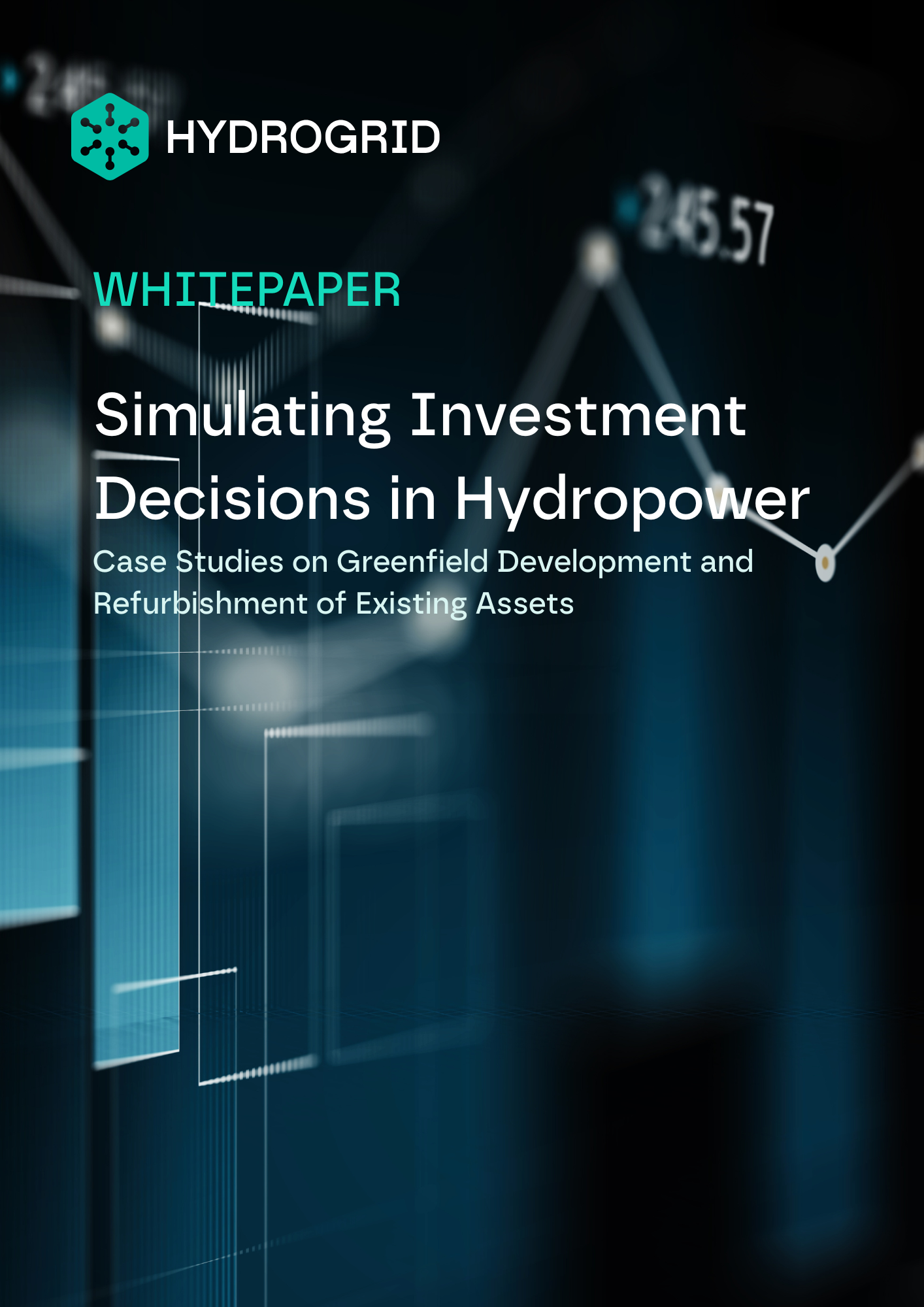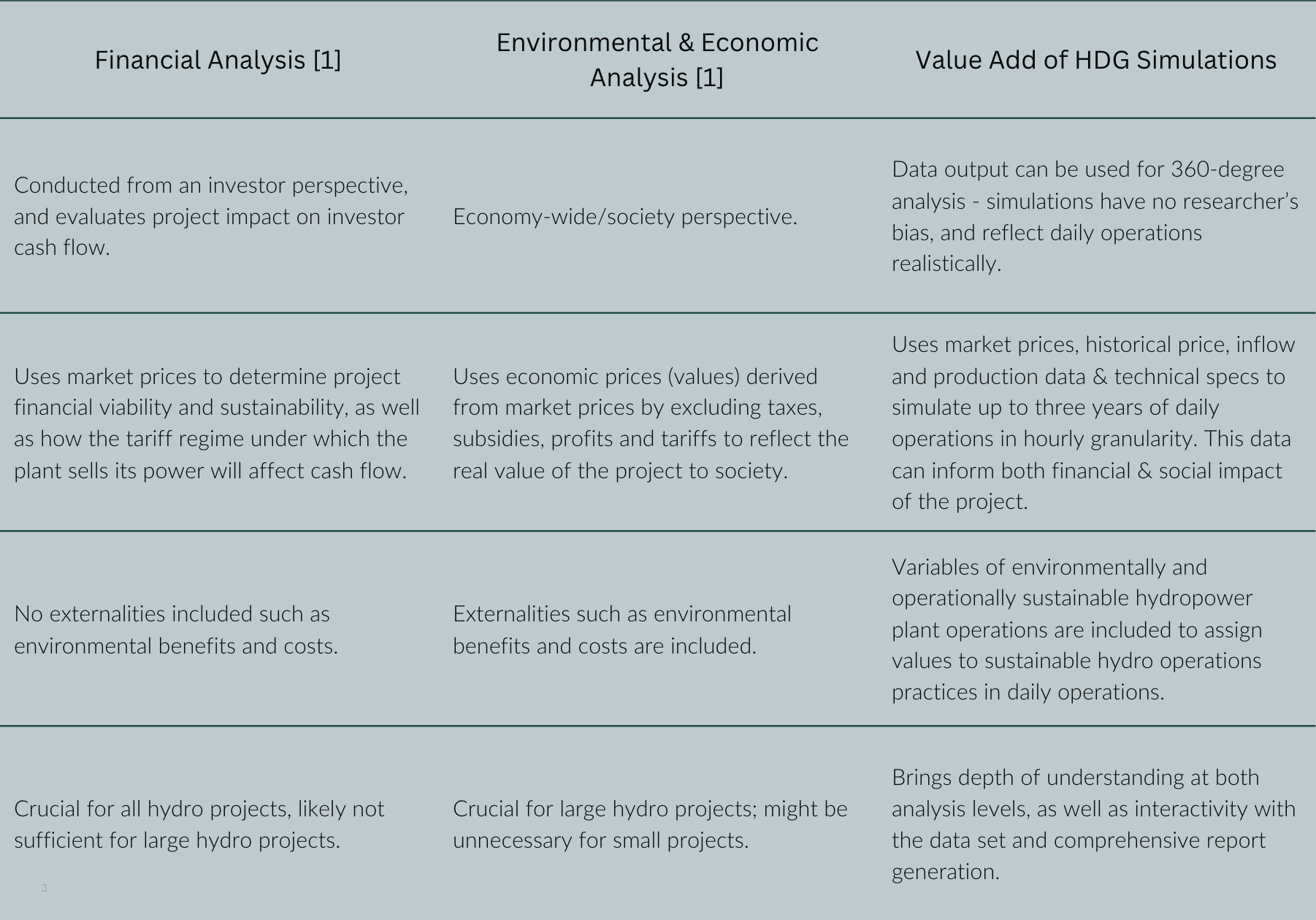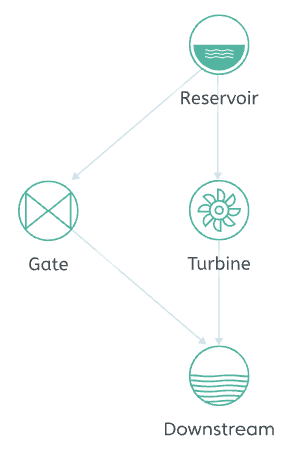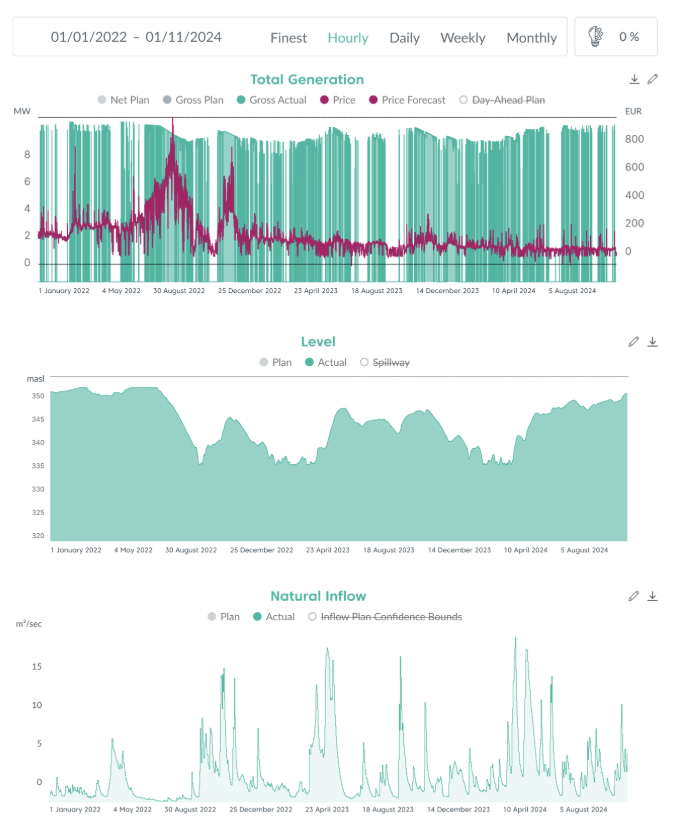Simulating Investment Decisions in Hydropower
Strategic hydropower investments demand precision. Discover Investment Decision Simulation (IDS), a digital methodology that leverages digital twins and ML-based forecasting to evaluate financial viability with unparalleled accuracy. From greenfield project feasibility to asset retrofits and M&A, this paper demonstrates how high-resolution scenario analysis quantifies risk and maximizes return on investment.

Introduction
This whitepaper explores the methodologies and tools used to simulate investment decisions for hydropower, highlighting how these high resolution simulations can optimize financial outcomes and enhance decision-making processes.
Strategic investment in hydropower plays a critical role in shaping the future of sustainable energy systems. Whether developing a new hydropower plant (HPP) or upgrading an existing one, the decisions made during the planning phase have long-term implications for financial viability, operational efficiency, and environmental impact.
The development of a new HPP—from initial concept to commercial operation—is typically a long-term endeavor, often spanning a decade or more. This is especially true for medium and large-scale projects, which must navigate complex permitting processes, environmental assessments, stakeholder negotiations, and infrastructure planning. Each phase demands careful evaluation of technical feasibility, market conditions, and regulatory frameworks.
For existing hydropower assets, refurbishment and modernization projects present a different set of challenges. These initiatives must account for the site's historical performance, existing infrastructure, and operational constraints. Moreover, any investment must align with the production and trading strategies already in place, ensuring that upgrades enhance—not disrupt—ongoing operations.
In both contexts, scenario analysis is highly sought after, labour and time intensive, but increasingly essential. Investment Decision Simulation (IDS) solves a recurring challenge in this process: the reliance on manually built hydrological models in spreadsheets. With IDS, analysts now have access to a faster, more interactive alternative that aggregates hourly data and simulates operational scenarios with high precision—eliminating the need to construct entire hydrological systems in Excel, or similar tools. Digital tools like HYDROGRID Insight propose a transformative approach, enabling stakeholders to evaluate multiple scenarios fast, interactively and in-depth.
The Impact
Investment Decision Simulation in hydropower is a sophisticated analytical process that enables developers, operators, and consultants to evaluate the financial and operational impact of various strategic choices. Rather than relying on static models or averaged values, digital simulations integrate real-world data and advanced modeling techniques, to support more confident, data-backed decisions and help shift the focus from analysis to implementation.
At its core, the methodology integrates a wide range of variables, including:
- Telemetry data from existing assets;
- Historical inflow records and power market data, from publicly available sources & internal records;
- Hydrological and operational constraints specific to each site;
- Efficiency curves of both current and considered hardware configurations;
- Seasonal inflow trend development, and
- Water value calculations that reflect the economic worth of stored or released water under different market conditions.
These inputs are processed through HYDROGRID Insight’s platform, which is built on a robust foundation tailored specifically for hydropower operations. The outcome of these high resolution simulations is a set of detailed, interactive reports that quantify return on investment (ROI) across multiple weather and market scenarios. This enables stakeholders to make informed decisions with confidence, shifting focus from feasibility analysis to implementation planning. Here’s how IDS data sets can add value in investment analysis:

Technologies Involved
(Digital twin) modeling of topology and water system
Digital twin technology creates a virtual replica of a hydropower asset, allowing developers and operators to simulate real-time behavior under various technical and market conditions.
This includes modeling different plant layouts, turbine configurations, and investment scenarios with hourly resolution. By mirroring actual operations—including inflow variability, dispatch constraints, and market dynamics—digital twins enable precise testing of upgrade options, operational strategies, and long-term performance, all before physical implementation.
Greenfield projects are built directly into the platform, using different scenarios proposed in pre-feasibility and feasibility studies.
Incorporation of hard and soft constraints, efficiency curves, and power price estimates
Hydropower operations are governed by a complex mix of constraints—some fixed, such as regulatory limits, and others flexible, like market-driven dispatch strategies.
These constraints often interact in ways that narrow the range of optimal operating conditions. Simulation tools help navigate this complexity by incorporating both hard and soft constraints, along with efficiency curves and power price estimates, to identify the most effective operational strategies.
For example, historical performance data can be benchmarked against regulatory requirements and technical parameters to evaluate how different inflow scenarios and turbine configurations would perform. This allows developers to pinpoint the best-fitting hardware and operational setup for a given site, ensuring that decisions are both technically sound and economically optimized.
Advanced ML-based inflow forecasting using historical data
One of the defining characteristics of hydropower is its dependence on water flow, which is inherently variable due to weather conditions and seasonal patterns. This variability directly affects power generation and, consequently, income from power sales—particularly in run-of-river projects, where storage capacity is limited and inflow fluctuations have immediate operational impacts.
By incorporating seasonal inflow trend development, historical hydrological data, and machine learning-based forecasting, IDS enables stakeholders to model how different weather scenarios affect generation potential and revenue.
These simulations produce detailed ROI reports across a range of hydrological conditions, allowing developers and operators to plan investments with greater confidence and precision.
The simulation engine combines advanced machine learning-based inflow forecasting, digital twin modeling, and the ability to incorporate both hard and soft constraints to reflect regulatory, technical, and environmental realities. Digital twin modeling of current operations and investment options.
Applications in New Project Development
Feasibility and Scenario Testing for Greenfield Projects
During pre-feasibility and feasibility studies, developers must make critical design and investment decisions based on site-specific conditions such as available water, seasonal variability, market needs, and topography. These decisions—like determining optimal storage capacity or selecting the appropriate head—directly influence plant layout, turbine choice, and long-term performance.
At this stage, high-resolution simulation tools provide valuable support by allowing teams to test multiple design configurations against realistic inflow and market scenarios. Instead of relying solely on static assumptions, developers can explore how different technical setups perform under varying conditions, helping to identify risks early and optimize key parameters. This leads to more robust project planning and strengthens the case for financing and implementation.
A recent example of this approach is the case of Hyvity, which used Investment Decision Simulation to evaluate different layouts for a closed-loop pumped storage project located in a desert region. The project’s unique context—essentially functioning as a large-scale battery—required careful consideration of reservoir sizing and head selection to match the site’s geological constraints and market dynamics.
Hyvity’s simulations focused on optimizing the system’s ability to store excess solar energy during the day and release it during peak demand hours at night, capitalizing on the distinct price spread created by the region’s high solar market share. The modeling accounted for cycle efficiency, ensuring that the energy losses from pumping and generating were offset by sufficient price differentials.
Additionally, the simulation incorporated evaporation losses, a critical factor given the arid climate and open water surfaces. By testing various reservoir sizes and head configurations, Hyvity was able to identify a layout that maximized profitability while maintaining operational resilience. The result was a data-backed design strategy that aligned technical feasibility with market opportunity—demonstrating how IDS can turn complex environmental and economic variables into actionable investment insights.
Stakeholder Alignment and Approval
Financing new hydropower projects is inherently complex due to several hydro-specific characteristics. These include the variability of hydrology, the potential for cost overruns and delays during construction, and the long-term nature of benefits that often span decades. These factors introduce uncertainty that can make investors and lenders cautious, especially in early-stage planning.
Investment Decision Simulation (IDS) offers a powerful way to address these concerns by providing transparent, data-driven justification for capital allocation. Through high-resolution modeling of inflows, market prices, operational constraints, and hardware performance, IDS generates detailed forecasts of financial returns under multiple weather and market scenarios. This enables developers to present quantified risk-adjusted ROI projections, meant to increase confidence more than relying on static or averaged values could. Below are just three examples of how IDS can bring value to industry standard financial assessment calculations:

Applications in Existing Project Optimization
Hydropower assets already in operation present unique opportunities for optimization, reinvestment, and strategic planning. Investment Decision Simulation (IDS) supports these efforts by enabling detailed scenario testing for retrofits, relicensing, and asset valuation—helping operators unlock hidden value and improve long-term performance.
Operational Upgrades and Retrofits
Norwegian hydropower developer CADRE AS partnered with HYDROGRID to evaluate the potential of adding an additional turbine to an existing system using HYDROGRID Insight’s IDS, when compared with a simple turbine update of the existing setup. The goal was to assess the financial and operational impact of the upgrade based on real-world operational data.
Initial Performance Calculation for CADRE


Using HYDROGRID Insight, CADRE was able to simulate three years of operational data in just three days. The team opted to model three weather scenarios: one dry year, an average inflow year, and a particularly wet year. This was achieved through the platform’s digital twin technology, which integrates real inflow data, market price forecasts, and operational constraints into a high-resolution, interactive model. The simulation provided a detailed and transparent view of the asset’s performance under various scenarios.
The three weather scenarios were applied on the considered hardware updates and the potential of adding a second turbine to the existing configuration. The results were compelling: the analysis projected a 14.5% increase in annual revenue resulting from the addition of a turbine to the existing setup. This enabled CADRE to make a confident, data-backed investment decision and shift focus toward implementation.
This case illustrates how investment decision simulation can deliver fast, in-depth insights that bypass lengthy calculation processes, the use of averages and estimates. In this case, using simulations significantly accelerated project timelines—empowering developers to act with clarity and precision.
Simulation Dashboard - Hourly Granularity Simulation

Best Performing Simulation of an Additional Turbine

M&A and Asset Valuation
Rather than testing hardware configurations, the focus in M&A simulations shifts to evaluating operational strategies, inflow variability, and market price fluctuations. Traditional approaches to assessing hydropower assets can be time-consuming and oversimplified, relying heavily on historical averages and static assumptions. IDS provides a more dynamic and transparent alternative.
Once the original plant topology is modelled—including technical specifications, operational constraints, and environmental boundaries—IDS enables rapid, interactive simulations of multiple scenarios. These simulations are fully documented and can be tailored to reflect realistic dispatch behavior, regulatory conditions, and market dynamics.
This approach allows buyers to move beyond seller-provided data and uncover the true value of an asset under optimal operations. By quantifying performance across a range of conditions, IDS helps reduce acquisition risk, support due diligence, and strengthen negotiation positions with data-backed insights.
Strategic and Financial Benefits
Investment Decision Simulation (IDS) has become a highly attractive addition to the documentation and analysis process across a wide range of hydropower investment contexts—whether it's a feasibility study for a greenfield project, a retrofitting initiative, a relicensing negotiation, or a merger and acquisition (M&A) evaluation. Its versatility lies in its ability to generate high-resolution, scenario-based data that complements and strengthens traditional financial metrics like FIRR, NPV, and LCOE.
One of the most valuable contributions of IDS is its fine granularity. Instead of relying on annual averages or static assumptions, IDS simulates hourly operations, inflows, and market conditions. This level of detail allows stakeholders to test how a project performs under varying weather patterns, regulatory constraints, and market price fluctuations—providing a much clearer picture of risk and opportunity.
By enhancing conventional estimates with dynamic, data-rich simulations, IDS builds confidence in investment decisions. It helps validate assumptions, uncover hidden risks, and demonstrate the robustness of a project’s financial outlook. For investors, lenders, and regulators, this added layer of transparency and precision can be the deciding factor in moving a project forward.
Sources:
[1] Hydroelectric Power-A Guide for Developers and Investors, World Bank
https://ppp.worldbank.org/public-private-partnership/sites/default/files/2021-10/Hydroelectric Power - A Guide for Developers and Investors.pdf
[2] Financial Modeling Assessment: How to Build and Use Financial Simulations and Scenarios, Faster Capital
https://fastercapital.com/content/Financial-Modeling-Assessment--How-to-Build-and-Use-Financial-Simulations-and-Scenarios.html
Get in touch with our hydro consultants to learn how!

